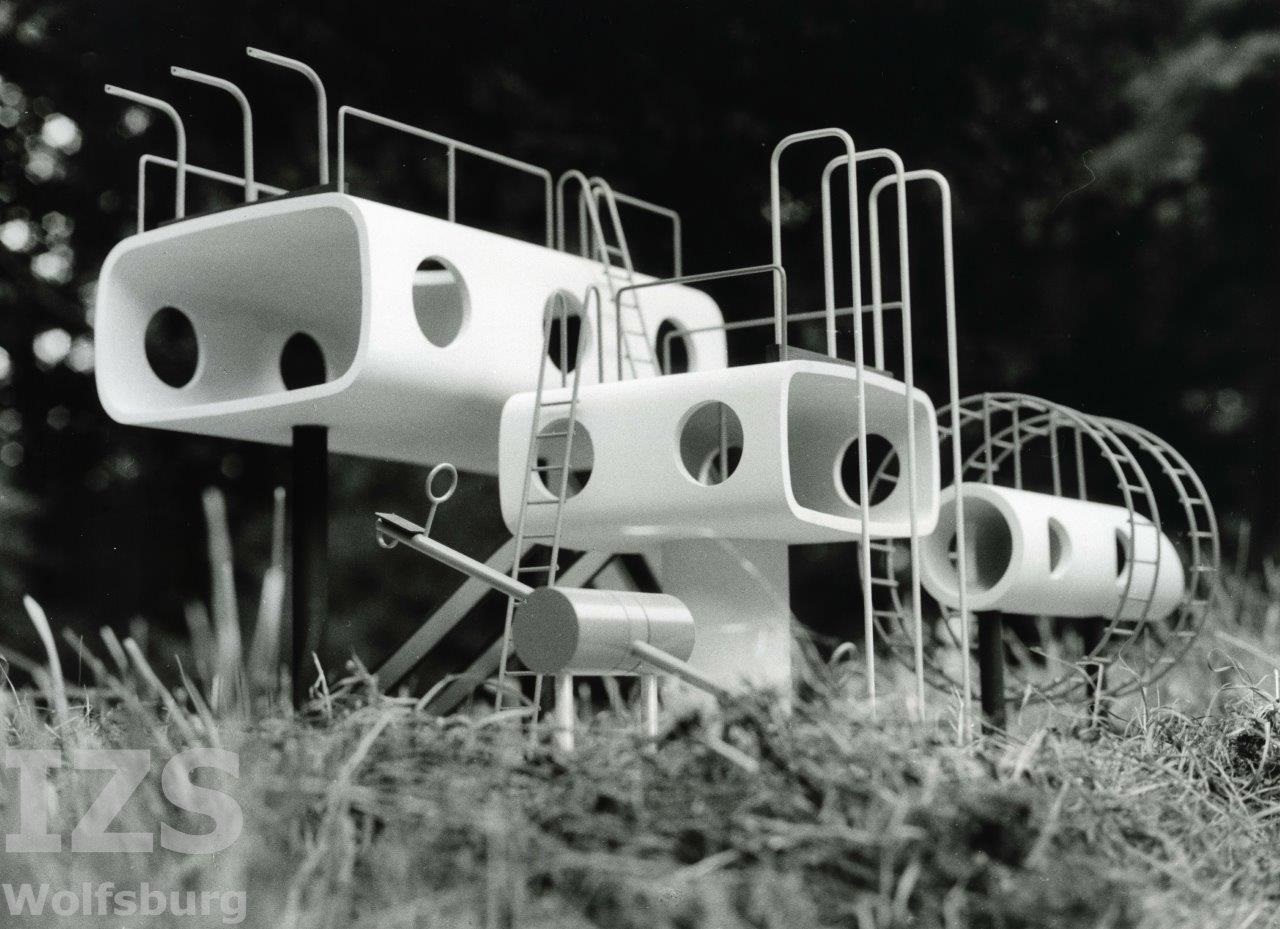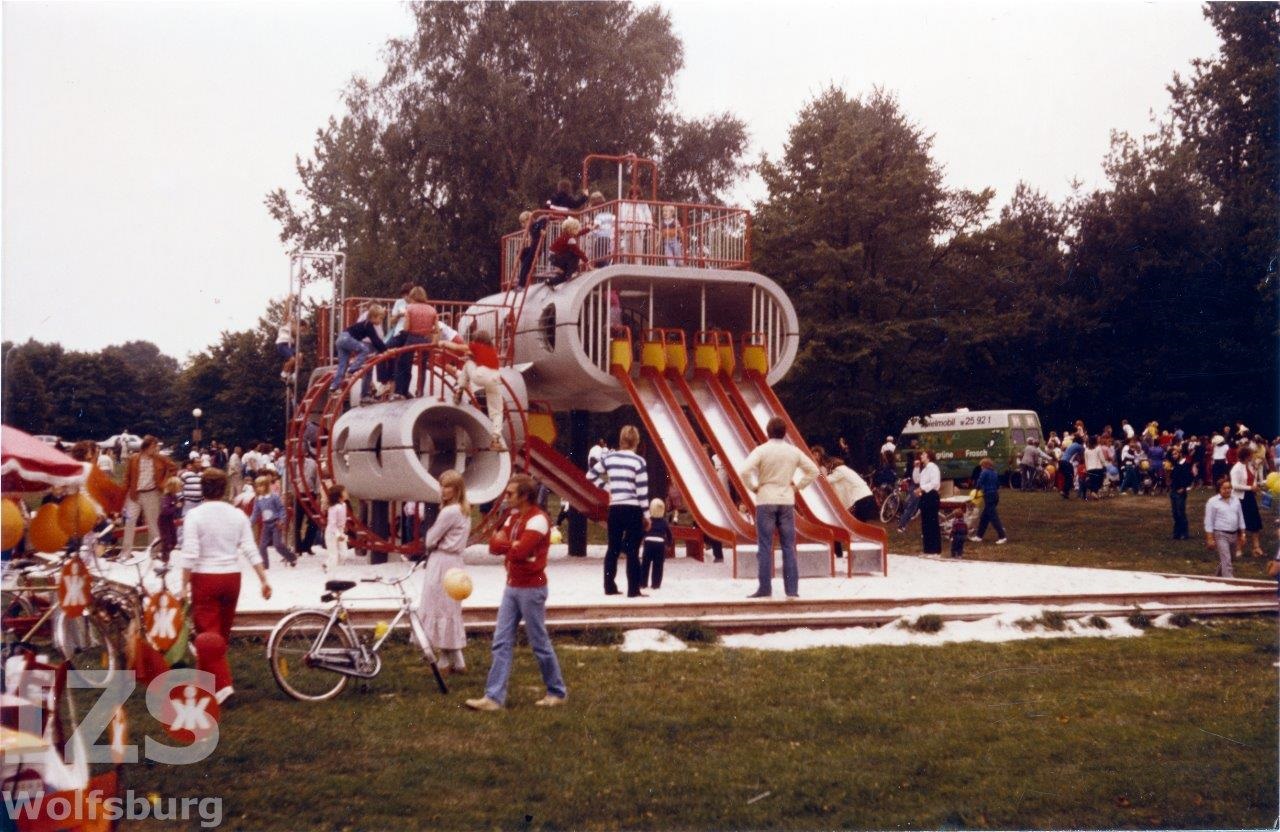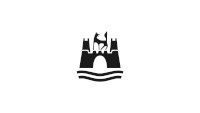Playground sculpture, Jochen Kramer (1979)
From Maik Ullmann
"16-year-old Heike Ehlers looks up in disbelief at the play sculpture by Wolfsburg sculptor Jochen Kramer. Flashing steel pipes, dull, tired concrete, decorated with countless slogans and graffiti. The object was erected at Schillerteich over four years ago. At the time, there was a hail of letters to the editor, complaints to the city's citizens' hotline and energetic inquiries from distraught councillors. 'It doesn't fit in here', the schoolgirl stated succinctly." -__-0000-__-
In short: Jochen Kramer's playground sculpture at the Großer Schillerteich in Wolfsburg was anything but popular in the first few years after its installation (Fig. 1). The citizens of Wolfsburg met the sculpture largely with incomprehension. Why put up such a structure? Trees and grass would suffice. A transcript of a Wolfsburg resident's complaint call to the city's citizens' hotline shows how indignantly the residents reacted to the sculpture and the events at the Schillerteich: "The tubular monstrosity, which disfigures the beautiful natural landscape at the Schillerteich behind the Christuskirche, is generally rejected because of its ugliness and, above all, because it is dangerous as a children's play equipment",-__-0001-__- was the harsh verdict conveyed by telephone. In an interview with the Wolfsburger Allgemeine Zeitung in the late summer of 1985, the artist sought answers to the skeptical questions from the public. According to Kramer, there was a lack of artistic education in Wolfsburg: "And, let's be honest, it's no different in the council",-__-0002-__- the artist continued to tease. Kramer was one of the mostly young artists who had moved to Wolfsburg in the 1960s and were supposed to give Wolfsburg a face by designing the public space.

Kramer's playground sculpture is a three-part construction made of gray steel and concrete and thus reflects the zeitgeist of the 1970s. The circular and oval play areas, which are held in the air by black steel poles and whose shape clearly sets them apart from classic climbing equipment, are particularly noteworthy. They are arranged next to each other at descending heights on a sandy surface. Viewed from the front, the sculpture looks little like a piece of playground equipment. Rather, it looks like an abstraction of an urban-brutalist utopia. It is only the numerous colorful climbing poles and slides on the back of the sculpture and the red seesaw that reveal that Kramer's object at Schillerteich is a modern play structure for children.
After several of Kramer's works, such as the bronze wolf in the Bürgerhalle or a mobile in Westhagen, had already adorned Wolfsburg's public spaces, another was to follow with the playground sculpture in 1979. But it was a long road to get there: the city's art advisory board had already made a recommendation five years earlier,-__-0000-__- after initial plans had been shown as part of the exhibition Kunst im Stadtbild by the Schloßstraße 8 group in Wolfsburg in 1974. -__-0001-__- After the planning contract was awarded, it was still necessary to check to what extent a "cost-saving design" was possible and - more importantly - whether the "safety" of the children could be guaranteed. "The planning will be completed around mid-April", -__-0002-__- the Culture Committee was told in March 1975.
However, a timely realization of the sculpture was out of the question (Fig. 2): -__-0003-__- Acute safety concerns regarding its use initially prevented the practical implementation of Kramer's designs.-__-0004-__- Climbing poles were to be installed instead of climbing ropes; a sliding pole had to make way for a ladder; railing work was to be carried out "in accordance with building authority guidelines". -__-0005-__- Looking at an early model of the sculpture, it becomes clear that some elements were added and redesigned. Kramer was prepared to follow the instructions, as the building authority's regulations did not affect his artistic intention: "The creative aspect of the sculpture should encourage the children to be active." And so Jochen Kramer's contribution to art in the cityscape can also be interpreted as an object with an art-educational character, which, according to him, the city still lacked.

In the summer of 1977, all safety concerns seemed to have been overcome; the city council decided by a majority vote to "erect the 'playground sculpture' by Jochen Kramer on the large Schillerteich -__-0001-__- at a total cost of around DM 187,000". -__-0002-__- However, further potential safety deficiencies subsequently had to be remedied. -__-0003-__- The Wolfsburger Kurier mockingly asked at the time whether cushions still had to be placed around the device. -__-0004-__- In the meantime, the implementation threatened to exceed the agreed financial framework,-__-0005-__- which is why City Planning Councillor Kern even called for the council resolution to be revoked at times. A much more positive perception of the supposed "tube monstrosity-__-0006-__-" is conveyed by a photograph of the inauguration of the sculpture from 1979 (Fig. 3). The photograph shows a colorful hustle and bustle of cheerful families. Numerous children are happily climbing around on the play sculpture. There doesn't seem to be any danger in the air here. The climbing poles added by Kramer and the ladder, which were intended to ensure safe use of the equipment, are clearly visible. In the end, the council and the artist came to an agreement. A sculpture was realized that is a symbol of forward-looking art policy, even if this was perceived differently by some of the population at the time.

-__-0000-__- "Art against indifference", in Wolfsburger Allgemeine Zeitung of August 19, 1985.
-__-0001-__- IZS Wolfsburg, Az. 47 52 20, Kunst im Stadtbild, Spielplastik, Referat Presse und Information, Betr.: Bürgerwünsche per Telefon vom 31. Juli 1980.
-__-0002-__- Ibid.
-__-0003-__- IZS Wolfsburg, ref. 47 52 20, Kunst im Stadtbild, Spielplastik, note on the meeting of the Art Advisory Board on May 22, 1974.
-__-0004-__- IZS Wolfsburg, ref. 47 52 20, Kunst im Stadtbild, Spielplastik, written report by the Education and Culture Office to the Culture Committee of March 27, 1974; IZS Wolfsburg, ref. 47 52 20, Kunst im Stadtbild, Spielplastik, minutes of the 15th meeting of the Culture Committee of June 7, 1974. On the history of the sculpture, see also Ulrich Brinkmann, "Kunst zum Klettern, runderneuert", in: Bauwelt (2013), no. 17/18, pp. 46f. The ideas for a light-kinetic object by Heiko Tappenbeck and Olga Szaif-Pawlowa's design for a color object also go back to this exhibition. However, the objects were not purchased. See IZS Wolfsburg, Ref. 47 52 20, Kunst im Stadtbild, Spielplastik, Minutes of the 11th meeting of the Art Advisory Board on February 26, 1976.
-__-0005-__- IZS Wolfsburg, ref. 47 52 20, Kunst im Stadtbild, Spielplastik, Minutes of the 23rd meeting of the Cultural Committee on March 7, 1975.
-__-0006-__- IZS Wolfsburg, ref. 47 52 20, art in the cityscape, play sculpture, memo from the building construction office dated October 14, 1975.
-__-0007-__- The concerns have never disappeared to the present day. See IZS Wolfsburg, ref. 47 52 20, Kunst im Stadtbild, Spielplastik.
-__-0008-__- Here and in the following IZS Wolfsburg, ref. 47 52 20, Kunst im Stadtbild, Spielplastik, memo from the Hochbauamt dated April 29, 1976.
-__-0009-__- IZS Wolfsburg, ref. 47 52 20, Kunst im Stadtbild, Spielplastik, excerpt from the minutes of the 18th public meeting of the city council on June 15, 1976.
-__-0010-__- IZS Wolfsburg, ref. 47 52 20, Kunst im Stadtbild, Spielplastik, Hauptamt Arbeitssicherheit an das Hochbauamt vom 9. März 1979.
-__-0011-__- "Art as a killer of children?" In: Wolfsburger Kurier from December 12, 1979.
-__-0012-__- IZS Wolfsburg, ref. 47 52 20, Kunst im Stadtbild, Spielplastik, memo from the Education and Culture Office dated April 21, 1978.
